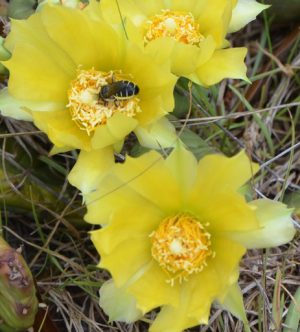
By Les Harrison
Wakulla County Extension Director
April showers produce May flowers, as the old saying goes. That adage assumes there are April showers, but the liquid from above was scarce for Wakulla County in April 2017.
This year’s spring bloom of native plants has been influenced by the dry April, the late March frost and the relatively warm winter. There are hardy “late-bloomers” which are barely effected by the weather’s fickle behavior.
Opuntia humifusa, commonly known as the Eastern Prickly Pear or Indian Fig has reflected no problems with the environment. Late April to early June is the prime blooming period for this Wakulla County native, rain or no rain.
Prickly pear is a true cactus which are native only to the western hemisphere. This plant family varies greatly in height depending upon which of the over 200 members is represented.
The leaves of prickly pear cactus are inconspicuous in appearance, but its plate-like sections of the stem are often misidentified as leaves. These sections are may reach a length up to six inches.
Stem sections remain green as they age and are covered with needle-sharp three inch-long spines or quills. The larger spines are quite capable of inflicting painful wounds.
There are also tiny spines, known as glochids, which are located in the areoles, those small light to dark colored bumps on the pear shaped stem sections. These can cause a lot of irritation if they pierce clothing or attach to the skin surface.
The flowers of this plant are produced in large numbers and create a striking contrast to their earth colored surroundings. The plant will bloom over a period of several weeks, but individual flowers only last one day.
The cup shaped flowers appear on the outermost plate like stem sections and may reach three inches in width. The color most commonly encounter is yellow, but orange and red variations are occasionally encountered.
Bright red to purple berries develop from the flowers, appearing in mid to late summer at the plant’s maturity. These plants are well-suited to hot, dry conditions and will tolerate summer droughts.
For best growth it requires a sunny, well-drained site and is tolerant of sandy, alkaline soils which are common in Wakulla County. Prickly pear will only tolerate wet conditions for a very short period of time before root rot becomes a problem.
While prickly pear does produce seed, the conditions for germination are very specific. Most propagation is accomplished by plant fragmentation.
The plate like sections need only have slight contact with moist sand to obtain rooting. This reproduction process turns prickly pear from a seasonal curiosity to a chronic problem for landscape managers, cattlemen and hay producers.
Mowing is a frequent means of weed control and stimulating grass growth. But mowing prickly pears detaches and scatters the pads which quickly root. Although prickly pear will not form dense canopies or overwhelm desirable forage grasses its rapid spread causes issues, depending on the situation.
The impact on grazing livestock has severe potential because of its barbed quills. Once the quills penetrate they are difficult to remove and may cause infection.
This cactus is eaten by gopher tortoises and is a favorite of pollinators, but has no pests or diseases of great concern. Rain or shine, this late bloomer produces bright flowers.
To learn more about prickly pear and Wakulla County’s other native cacti, visit the UF/IFAS Wakulla County Extension website at https://blogs.ifas.ufl.edu/wakullaco or call 850-926-3931.
 0
0
